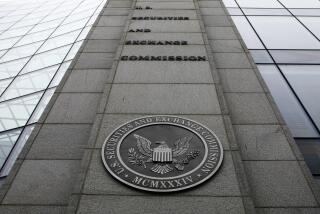Reward for Bin Laden Enters New League
WASHINGTON — From a $5,000 bounty on Jesse James in the 1880s to the $25-million reward for Osama bin Laden today, authorities have dangled cash to catch people accused of big crimes. The principle remains the same: Money talks.
Over the years, the government has doled out millions to motivate people to turn in everyone from tax evaders to international terrorists. But the $25 million offered for Bin Laden is in a new league.
Terrific money for an American, it’s an almost unfathomable sum in Afghanistan, where per capita income runs about $200 a year. It’s equal to nearly 10% of U. S. humanitarian assistance planned for the entire country this fiscal year.
Although the chances of a government reward actually paying off are generally low, prospects are somewhat better in terrorism cases.
“Pretty much the only place where a reward works is in the area of terrorism,” said Jack Levin, director of the Brudnick Center on Violence at Northeastern University in Boston. That’s because terrorists’ associates aren’t apt to help out without financial incentive.
The government’s biggest reward payout so far: $2 million for the unidentified informant who in 1995 helped the government find Ramzi Yousef in Pakistan. Yousef was convicted of leading the 1993 World Trade Center bombing.
Other big reward offers: $5 million for former Yugoslav President Slobodan Milosevic and other senior officials indicted for war crimes; $2 million in the Oklahoma City bombing; $1 million still available for Eric Rudolph, wanted for the 1996 Olympics bombing and other crimes; $1 million for Unabomber Theodore Kaczynski, and $1 million for Panamanian leader Manuel Noriega.
Of those, only the Unabomber reward was paid because the other fugitives now in custody were captured principally without informants.
The notion of people turning one another in for cash dates to ancient times. The Bible says Judas Iscariot collected 30 pieces of silver for betraying Jesus Christ.
“It’s been going on forever and ever,” said Gilbert Geis, a criminology professor emeritus at UC Irvine.
Until a few weeks ago, the most the government could offer was $5 million, but the new anti-terrorism law boosted the limit to $25 million. Last week, Secretary of State Colin Powell signed the authorization for that amount to be applied to Bin Laden and other top Al Qaeda leaders.
Even before that, the Defense Department was dropping leaflets in Afghanistan and airing broadcasts dangling the $25 million.
The full $2-million payout in the Yousef case was a rarity. It turns out that there’s plenty of fine print attached to government rewards.
Often, criminologists say, tipsters get only a small portion of the money offered, depending on how big a role their information plays.
State Department spokesman Richard Boucher stresses that the reward for Bin Laden is “up to” $25 million.
Levin said rewards can be particularly effective in terrorism cases because those with critical information often “are themselves terrorists or they’re citizens of some other country who feel no allegiance at all to the United States.”
State Department officials say their “Rewards for Justice” program has paid out $8 million in 22 cases over seven years. The government won’t discuss specifics on who got what for fear of endangering informants.
The money isn’t just for bounties on criminals: It also can be used to reward tipsters whose information helps prevent planned acts of terrorism.
Since Sept. 11, the program has received 22,000 tips related to terrorist attacks, most through e-mail and telephone calls, but Boucher said none of the tips so far has produced a concrete result.
Criminologists caution that a big reward can also create big headaches.
“It brings out the pathological liars and those who would give us false leads and fabricated information,” Levin said.
Often, the rewards serve more as a symbolic gesture to show the government is concerned, said Geis, adding, “The $25 million is simply to make a big splash.”
Among others offering reward money:
* The Postal Service is offering $1.25 million for the anthrax attacker or attackers. It routinely offers up to $100,000 for information on mail-related crimes ranging from stealing mail to killing postal workers.
* The FBI has $1-million rewards pending for two people on its Top 10 “Most Wanted” list: Rudolph and reputed mobster James “Whitey” Bulger. Everyone on that list attracts at least a $50,000 bounty. FBI field offices can offer more.
* Last fiscal year, the IRS paid out $1.8 million to 382 people whose tips on truant taxpayers brought in $266.6 million in unpaid taxes.
More to Read
Sign up for Essential California
The most important California stories and recommendations in your inbox every morning.
You may occasionally receive promotional content from the Los Angeles Times.










